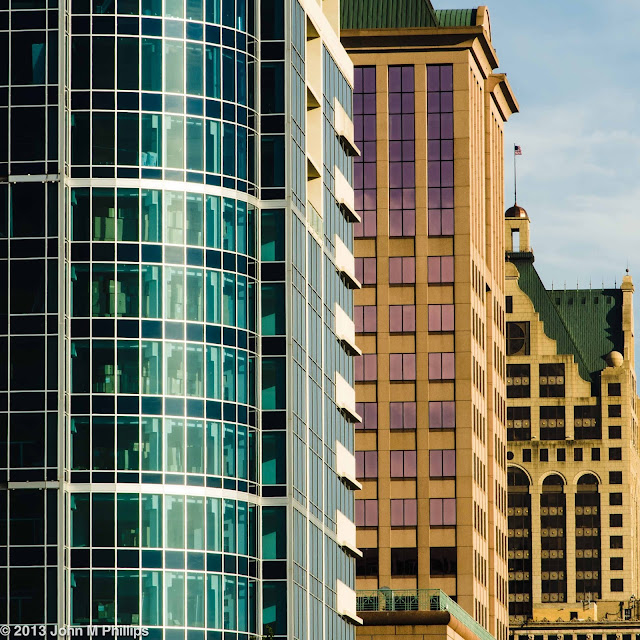I also caught the following three buildings situated on North Water Street in this foreshortened shot.
These buildings are actually each separated by a few blocks. I liked this composition for the diversity of architectural style and color in the three buildings.
Driving past the Marcus Center for the Performing Arts, I noticed that the sun was casting a shadow of a pedestrian bridge connecting the Center to a parking ramp to the north and took a couple of shots through the window of my car while waiting for a traffic light. Because of the angle of the sun, the ramp appears to be sloped, even though it actually is more or less level.
The pedestrians made the difference for these shots.
I also passed City Hall and took another shot through my side window.
I could have zoomed in on the "nudie" on the right, but decided that I wanted to include some of the other lines of this remarkable building.
Driving on down Water Street in the bright evening light, I couldn't help but notice that the facade of the Iron Block Building, which is located directly across the street from where I worked for 33 years, had been restored--again. I took one photo through the windshield of my car while waiting for a light to change and then found a parking space to take a few more photos before heading on to the south side.
The Iron Block Building dates back to 1860 and is unusual for its facade, which consists of cast iron blocks. When freshly painted in light cream the detail in the blocks can present an arresting sight. However, the cast iron is subject to rust and over time the building can begin to look pretty shabby. The building's current owner has just completed a many-months-long restoration of the facade, consisting of sandblasting, rustproofing, and repainting, and the building's surface was just re-exposed to the public within the last couple of weeks.
Here is a photo of the entire building, something I usually forget to do.
The west side of the building was in full sun, leaving the most of the north side in fairly deep shadow. I was able to do a decent job of bringing out the shadowed portion through post processing magic.
Here is the shot I took through the windshield of my car.
I was fairly happy with this shot, as the windshield was relatively clean. (This was before a bird nailed my windshield a little later in the evening.)
And here are a few more shots of the building once I was able to find a parking space.
Both of these photos were shot "straight on" but from street level. I was able to rectify the perspective in post processing. For the shots below, I didn't bother or else would not have been able to.
I believe the Iron Block lettering in the pediment of this last shot is new to this restoration effort.
The building's facade last underwent a major renovation in 1983. The current owners are hopeful that the current renovations will be more enduring. The building has been on the National Register of Historic Places since 1974.
John



























































